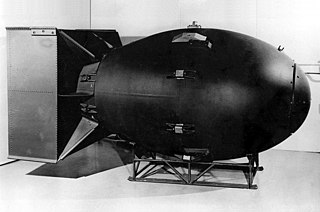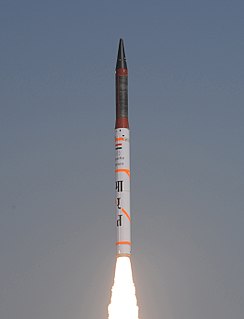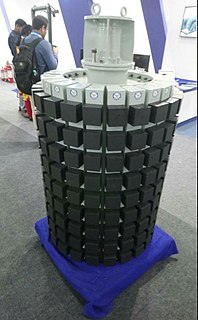
A ballistic missile submarine is a submarine capable of deploying submarine-launched ballistic missiles (SLBMs) with nuclear warheads. The United States Navy's hull classification symbols for ballistic missile submarines are SSB and SSBN – the SS denotes submarine, the B denotes ballistic missile, and the N denotes that the submarine is nuclear powered. These submarines became a major weapon system in the Cold War because of their nuclear deterrence capability. They can fire missiles thousands of kilometers from their targets, and acoustic quieting makes them difficult to detect, thus making them a survivable deterrent in the event of a first strike and a key element of the mutual assured destruction policy of nuclear deterrence. Their deployment has been dominated by the United States and the Soviet Union / Russia, with smaller numbers in service with France, the United Kingdom, China, and India.
A nuclear submarine is a submarine powered by a nuclear reactor. The performance advantages of nuclear submarines over "conventional" submarines are considerable. Nuclear propulsion, being completely independent of air, frees the submarine from the need to surface frequently, as is necessary for conventional submarines. The large amount of power generated by a nuclear reactor allows nuclear submarines to operate at high speed for long periods of time; and the long interval between refuelings grants a range virtually unlimited, making the only limits on voyage times being imposed by such factors as the need to restock food or other consumables.

The Republic of India has developed and possesses weapons of mass destruction in the form of nuclear weapons. Though India has not made any official statements about the size of its nuclear arsenal, recent estimates suggest that India has 110 nuclear weapons — consistent with earlier estimates that it had produced enough weapons-grade plutonium for up to 75–110 nuclear weapons. In 1999, India was estimated to have 800 kg of separated reactor-grade plutonium, with a total amount of 8,300 kg of civilian plutonium, enough for approximately 1,000 nuclear weapons.

Babur, also designated Hatf VII, is a short range turbojet powered subsonic cruise missile that can be launched from land or mobile underwater platforms. The missile was first tested in 2005 and is widely believed to have entered service with the Pakistan Army in 2010.

A nuclear triad is a three-pronged military force structure that consists of land-launched nuclear missiles, nuclear-missile-armed submarines and strategic aircraft with nuclear bombs and missiles. Specifically, these components are land-based intercontinental ballistic missiles (ICBMs), submarine-launched ballistic missiles (SLBMs), and strategic bombers. The purpose of having this three-branched nuclear capability is to significantly reduce the possibility that an enemy could destroy all of a nation's nuclear forces in a first-strike attack. This, in turn, ensures a credible threat of a second strike, and thus increases a nation's nuclear deterrence. The main theory of creating the nuclear triad was to spread the assortment of weapons across various platforms, making military forces more likely to survive an attack and able to respond to a first strike successfully. The military strategy of distributing weapons over the three platforms developed as an answer to countries' concerns when surviving a nuclear strike. This would ensure that nuclear forces could survive a first strike and be deployed in a retaliatory strike, resulting in "mutual assured destruction."

Sagarika, also known by the code names K-15 or B-05, is a nuclear-capable submarine-launched ballistic missile with a range of 750 kilometres (466 mi). It belongs to the K Missile family and forms a part of India's nuclear triad, and will provide retaliatory nuclear strike capability.
The Arihant class is a class of nuclear-powered ballistic missile submarines being built for the Indian Navy. They were developed under the ₹90,000 crore (US$13 billion) Advanced Technology Vessel (ATV) project to design and build nuclear-powered submarines.
The Agni missile is a family of medium to intercontinental range ballistic missiles developed by India, named after one of the five elements of nature. Agni missiles are long range, nuclear weapons capable surface to surface ballistic missile. The first missile of the series, Agni-I was developed under the Integrated Guided Missile Development Program and tested in 1989. After its success, Agni missile program was separated from the IGMDP upon realizing its strategic importance. It was designated as a special program in India's defence budget and provided adequate funds for subsequent development. As of 2008, the Agni missile family comprises three deployed variants while two more variants are under testing:

Agni-IV is the fourth in the Agni series of missiles which was earlier known as Agni II prime. It has been developed by India's DRDO and displayed a number of new technologies and significant improvement in missile technology. The missile is light-weight and has two stages of solid propulsion and a payload with re-entry heat shield. With a 4,000 km (2,500 mi) range, it is capable of striking targets in nearly all of mainland China if launched from northeastern India.
Agni-VI is an intercontinental ballistic missile being developed by the DRDO for the use of the Indian Armed Forces Strategic Forces Command.
The K family of missiles named after Indian scientist and former president A. P. J. Abdul Kalam, is a series of submarine-launched ballistic missiles (SLBM) developed by India to boost its second strike capabilities and thus augment its nuclear deterrence. Information about this family of missiles has mostly been kept classified. It is reported that "K" missiles are faster, lighter and stealthier than their Agni missile counterparts.
The use of rockets in India, for warfare, dates back to the 18th century. These rockets were the first iron-cased rockets that were successfully deployed for military use. The British reverse-engineered these and introduced the technology to Europe. When India became a British colony, scientific R&D in India was restricted and military science in India naturally lagged.

INS Arighat is the second Arihant-class submarine. It is the second nuclear-powered ballistic missile submarine being built by India. It is being built under the Advanced Technology Vessel (ATV) project to build nuclear submarines at the Ship Building Centre in Visakhapatnam. Arighat will have twice as many missile hatches as its predecessor INS Arihant, so it will be able to carry more missiles. It will also have a more powerful reactor than Arihant.

USHUS is an integrated sonar system developed by the Naval Physical and Oceanographic Laboratory (NPOL) of the Defence Research and Development Organisation (DRDO), India, for use in submarines of the Indian Navy. It is primarily designed to be used in Sindhughosh class submarines, though it is reported to be fitted in the Arihant-class nuclear-powered ballistic missile submarines as well. USHUS is reported to be superior to its Russian equivalents.
The Pukkŭksŏng-1 or Bukgeukseong-1, alternatively KN-11 in intelligence communities outside North Korea is a North Korean, submarine-launched ballistic missile (SLBM) that was successfully flight tested on 24 August 2016 and is expected by South Korean military sources to reach operational deployment as early as 2017.














